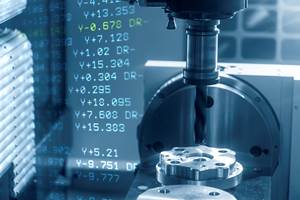Running EDM Economically
Many shops are taking a closer look at the cost of operating a machine tool. How much energy does it consume? Does it create excessive heat, making the shop air conditioning work harder? Does it stretch the life of cutting tools and consumables?
Share






Many shops are taking a closer look at the cost of operating a machine tool. How much energy does it consume? Does it create excessive heat, making the shop air conditioning work harder? Does it stretch the life of cutting tools and consumables?
Mitsubishi EDM (Wood Dale, Illinois) has been adding features and capabilities to its wire and ram EDM units to reduce operational costs. As the price of energy and raw materials edges up, every type of machine tool will have to be scrutinized for similar economies and cost-saving strategies.
Here are some examples of cost-reducing and energy-saving features found on Mitsubishi EDM's latest offerings, as the company describes them.
The EA12V die sinking machine is a medium-sized unit that handles workpieces as large as 820 by 550 by 250 mm.
- Its FP80V power supply has a power regeneration circuit that reduces power consumption by 20 percent compared to the FP60EA power supply it replaced. The regenerative power supply "saves excess energy from one spark and adds it up until enough energy is stored to make another spark."
- The FP80V reduces power consumption by 50 percent when machining carbide, compared to the older power supply, which had an optional SP circuit for machining carbide. The new supply unit does not require a special circuit for carbide cutting.
- The new power supply produces less heat, even when running under high energy settings. This lowers shop cooling costs and reduces the risk that changes to ambient temperature may affect nearby equipment.
- Dielectric fluid level in the worktank can be set in the NC program to minimize power consumed by the pump.
- The filtration system uses fine mesh, long-life filter elements that have double the surface area for trapping particles and have four times the life of previous versions.
- Clean dielectric fluid from enhanced filtration reduces secondary sparking for fine finishing and eliminates the wasted energy that results.
- In wire EDM, the FA-S series includes the FA10S, with a 350 by 250 by 220 mm machining range, and the FA20S, with a 1050 by 800 by 295 machining range.
- The AE power supply has a power regeneration circuit.
- The power supply consumes three times less resin compared to the power supply on previous models.
- An inverter pump drive reduces motor rpm as the load goes down when flushing volume drops during the switch from rough cutting to skim cutting.
- All pumps can be shut of with one M code at the end of the last program when running overnight or through the weekend.
- A CS (cost saving) mode reduces wire consumption by slowing down the wire feed as it passes from upper to lower guides. Because the wire travels more slowly, the effects of wear accumulate, producing a slight taper in the wire as it approaches the bottom of a cut. The wire becomes thinner as it goes down. To compensate for the taper, the CS mode provides a slight but precise offset to the perpendicularity of the wire, thus tilting it toward the taper to achieve high cutting accuracy.
- In the CS mode, the filtration system and high-pressure pumps turn off automatically between jobs.
For both wire and ram EDM, the savings add up and contribute both to the productivity and profitability of each operation.
Related Content
6 Machine Shop Essentials to Stay Competitive
If you want to streamline production and be competitive in the industry, you will need far more than a standard three-axis CNC mill or two-axis CNC lathe and a few measuring tools.
Read More4 Commonly Misapplied CNC Features
Misapplication of these important CNC features will result in wasted time, wasted or duplicated effort and/or wasted material.
Read More6 Variations That Kill Productivity
The act of qualifying CNC programs is largely related to eliminating variations, which can be a daunting task when you consider how many things can change from one time a job is run to the next.
Read MoreTips for Designing CNC Programs That Help Operators
The way a G-code program is formatted directly affects the productivity of the CNC people who use them. Design CNC programs that make CNC setup people and operators’ jobs easier.
Read MoreRead Next
Machine Shop MBA
Making Chips and 91ÊÓƵÍøÕ¾ÎÛ are teaming up for a new podcast series called Machine Shop MBA—designed to help manufacturers measure their success against the industry’s best. Through the lens of the Top Shops benchmarking program, the series explores the KPIs that set high-performing shops apart, from machine utilization and first-pass yield to employee engagement and revenue per employee.
Read MoreAMRs Are Moving Into Manufacturing: 4 Considerations for Implementation
AMRs can provide a flexible, easy-to-use automation platform so long as manufacturers choose a suitable task and prepare their facilities.
Read MoreLast Chance! 2025 Top Shops Benchmarking Survey Still Open Through April 30
Don’t miss out! 91ÊÓƵÍøÕ¾ÎÛ's Top Shops Benchmarking Survey is still open — but not for long. This is your last chance to a receive free, customized benchmarking report that includes actionable feedback across several shopfloor and business metrics.
Read More






















